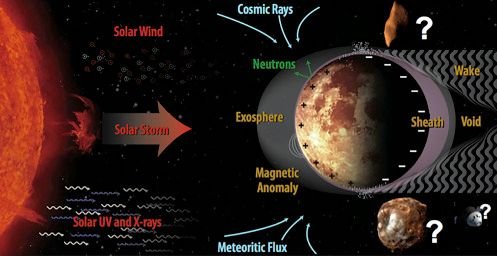Catalyst Discussion and Reaction to Lunar Science and Exploration Activities
Multiple SSERVI teams recently submitted to the ‘Catalyst’ section of the journal CHEM. The Catalyst approach is to find a new topic and have a discussion about it. The original article defining the issue is called a ‘Catalyst’ and the added comments to the article are called ‘Reactions’. In this case, Thom Orlando (PI REVEALS) wrote the original Catalyst article about REVEALS and William Farrell (PI DREAM2) and Bernard Foing (ESA) have each provided a ‘reaction’ article in response.
- Read Orlando’s Catlyst Article here.

Figure 1. Overview of Research to Be Conducted by the REVEALS Investigation Team:
(Top) Primary mechanisms of space weathering within the solar system; these include bombardment with solar wind, galactic cosmic rays, magnetospheric particles, and micrometeoroids. The formation of water and methane on airless bodies via solar wind will be investigated. Adapted with permission from Bennett et al. Copyright 2013 American Chemical Society.
(Bottom) Process of forming and testing fiber-reinforced polymer nanocomposites as spacesuit patches with potential electrical conductivity, thermal conductivity, and radiation-hardness control.
About Thomas Orlando
Prof. Thomas Orlando is a professor in the Georgia Institute of Technology (GIT) School of Chemistry and Biochemistry and an adjunct professor in the GIT School of Physics. He serves as director of the GIT Center for Space Technology and Research and as principal investigator (PI) of the NASA Solar System Exploration Research Virtual Institute Center on Radiation Effects on Volatiles and Exploration of Asteroids and Lunar Surfaces (REVEALS). The team is focused on understanding radiation effects on the regolith and the solar-wind formation of volatiles to help facilitate future human exploration of near-Earth destinations.
- Read Farrell’s Reaction here.
The studies by SSERVI teams such as REVEALS and DREAM2 not only connect back to the highest planetary science decadal goals regarding volatiles but also feed forward to understanding the chemical origins of potential resources at the surface-useful for human exploration.

Figure 1. The Energy Drivers at an Exposed Surface, such as the Moon, and the Surface Response
This response includes the formation of an exosphere, an exo-ionosphere, dust lofting, and a trailing solar-wind plasma wake. On DREAM2, we also consider the environmental variations at small exposed bodies such as asteroids and Phobos-and the effect on the local environment by human systems. See https://ssed.gsfc.nasa.gov/dream/.
About William Farrell
Dr. Bill Farrell is a plasma physicist at NASA’s Goddard Space Flight Center. He is a co-investigator on the Cassini mission to Saturn and the Parker Solar Probe mission. He is also principal investigator of the SSERVI DREAM2 Center for Space Environments (https://ssed.gsfc.nasa.gov/dream/), which examines the exosphere formation, radiation effects, and plasma interactions of the Moon and other airless bodies.
- Read Foing’s Reaction here.

Figure 1. “Moon Village” Habitat Concept with Inflatable Structure and Shield Protecting Astronauts and Equipment:
The shield can be built with a 3D printer and lunar regolith and can incorporate water ice available in polar soils. This material can provide stopping power against solar particle events, galactic cosmic rays, and meteoritic impacts. Image credit: ESA, Foster + Partners, and B.H.F.
About Bernard Foing
Prof. Foing is an advisor to the director general of the European Space Agency (ESA), a space astrophysicist at the European Space Research & Technology Centre (ESTEC), executive director of the International Lunar Exploration Working Group (ILEWG), and research professor at Vrije Universiteit Amsterdam and Florida Tech. He was chief scientist, chairman of the ESTEC staff association, and lead scientist for the ESA SMART-1 mission to the Moon. He is co-investigator of ESA missions SOHO, COROT, Mars Express, ExoMars, and EXPOSE experiments (FOTON capsules and International Space Station). He is manager of ILEWG ExoGeoLab and EuroMoonMars field simulations in extreme terrestrial analogs.
Hope You Will Like My Post!!!!
Thank You.

Loved the illustrations, was really appealing to read
Your Post Has Been Featured on @Resteemable!
Feature any Steemit post using resteemit.com!
How It Works:
1. Take Any Steemit URL
2. Erase
https://3. Type
reGet Featured Instantly – Featured Posts are voted every 2.4hrs
Join the Curation Team Here